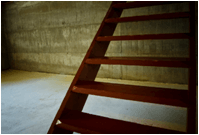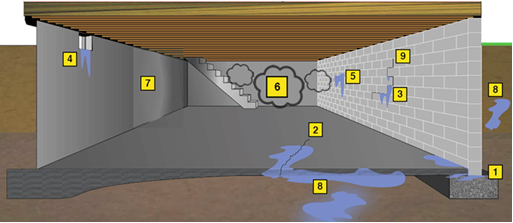Clay soils can become saturated with water. When this happens, the soil expands, pushing upward towards the foundation. As the soil dries, it contracts and the pressure is released. This hydrostatic pressure can cause foundation cracks, movement and even instability. Water can enter through these cracks, creating a wet basement.
What’s Lurking in Your Basement?
Basement leaks can come in through cracks in the wall, floor or the mortar joints of cinderblocks. Water actually can accumulate inside the blocks before you even know it is there. This can become a breeding ground for mold, which is a health risk, especially for anyone suffering from allergies or asthma.
Water can seep in from under the footer, located underneath the poured basement floor. Most basement construction leaves a space between the footer and the basement floor. When water comes into this area from poor exterior drainage or other issues, it can exert pressure on the foundation. This can cause foundation cracks and allow water to seep into the basement. Water may enter small cracks located between the footer and the wall atop it as well.
Basement window wells may also hold excess water that can leak into the basement. A leaking basement can suffer sweating walls that eventually pool on the floor. Every leaky basement needs attention or other problems can develop throughout the house.
How Leaks Enter Your Basement?
There are several different ways water can get into your basement.
- Water that comes from underneath and over your foundation’s footer
- Subsurface water that creeps up through cracks in the basement floor
- Water that seeps in through basement wall cracks
- Water that seeps in through windows or vents
- Sweating basement walls resulting from water vapor
- Wet basements lead to humidity
- Hydrostatic pressure and cause walls to bow
- Water can pool underneath the soil, near your home’s foundation leading to structural damage
Effects of a Wet Basement

When foundation problems that cause leaking basements are left unaddressed, the issues worsen. Homes with leaking basements should consider a water intrusion management solution to stop leakage issues and prevent future issues. Let a certified repair specialist help you determine the best foundation repair solution for your specific repair needs.


